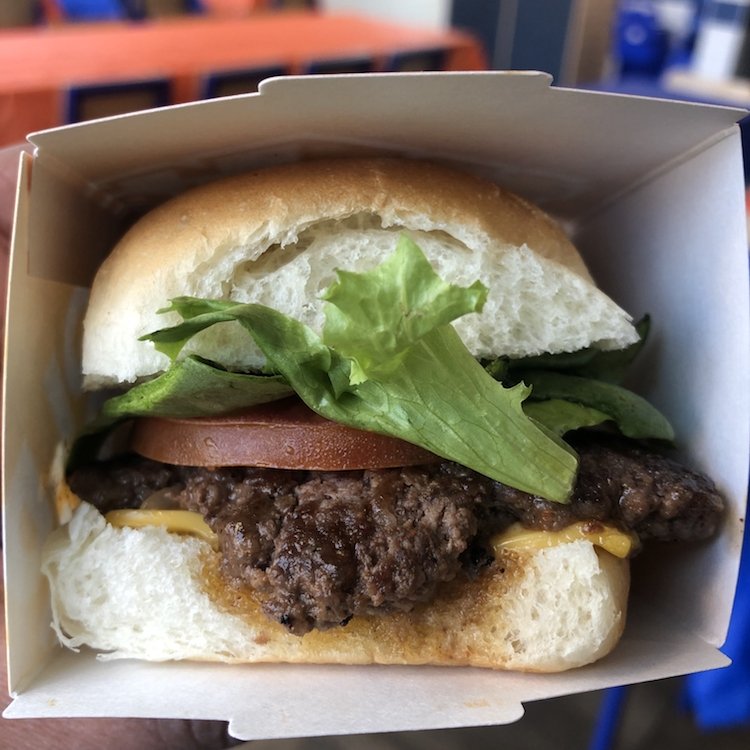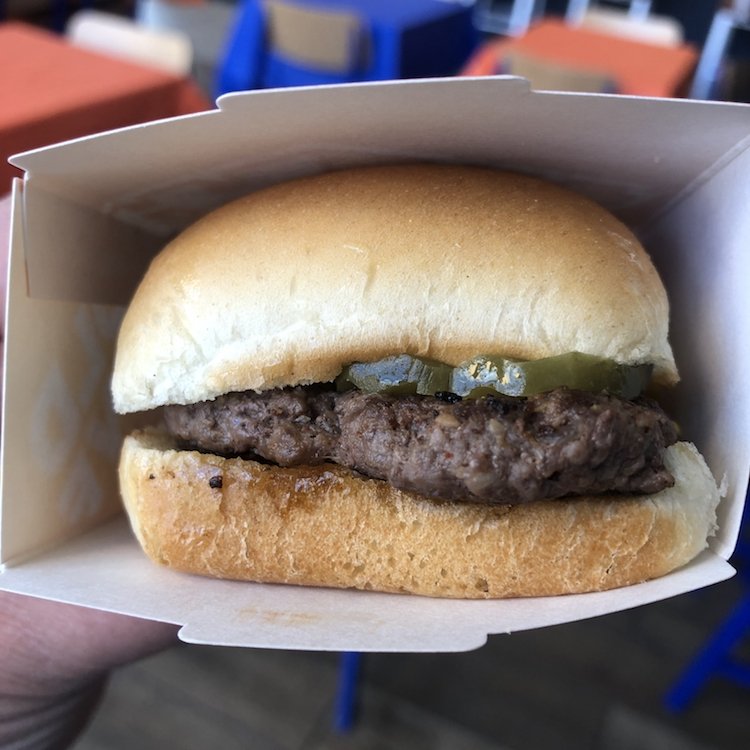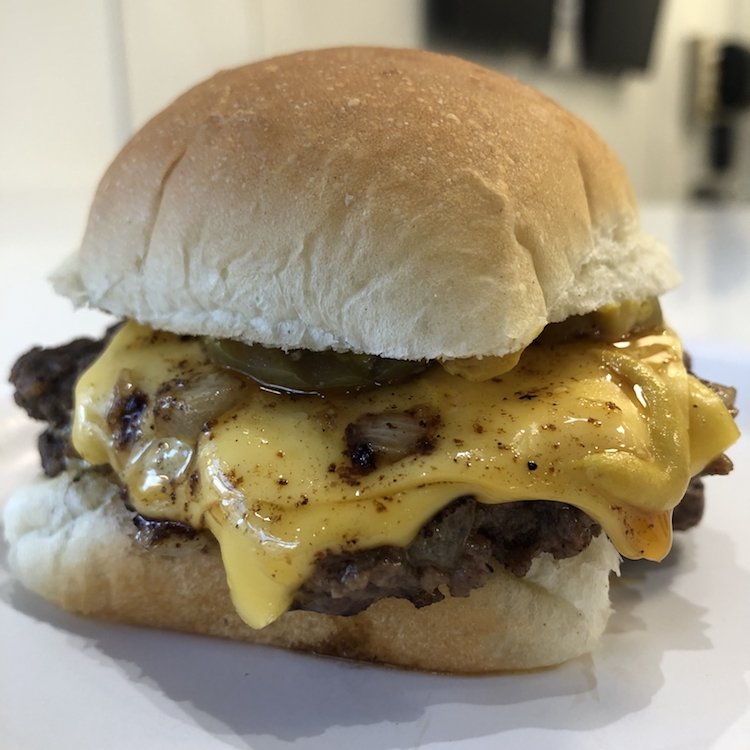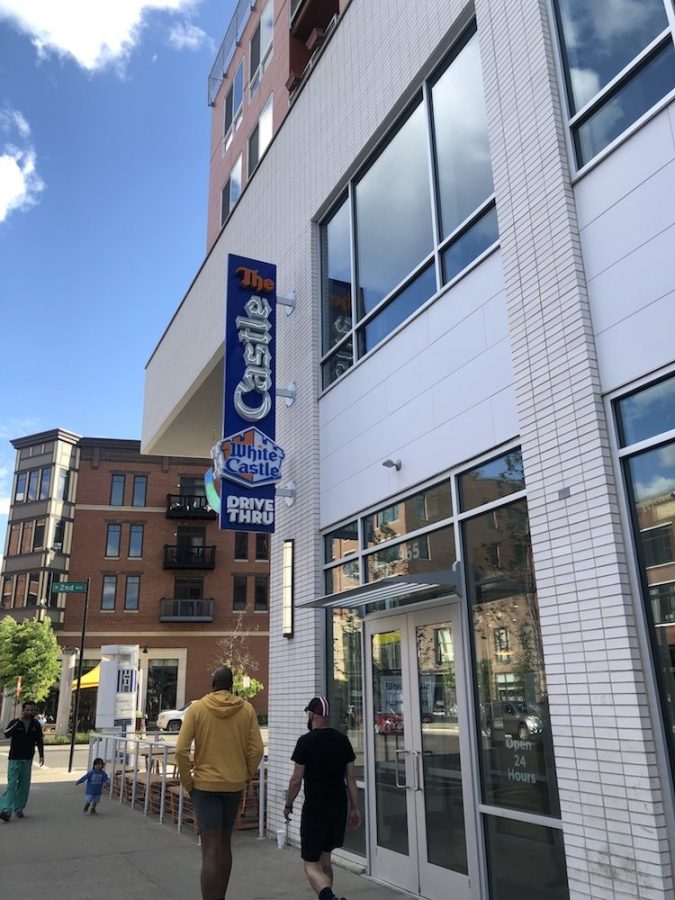White Castle‘s 1921 Slider is a fresh beef burger available only at two locations in Columbus, Ohio, one in Chicago, Illinois, Scottsdale, Arizona, and most recently Orlando, Florida. The name comes from the year that White Castle opened up operations, back when they smashed a ball of never-frozen beef with freshly chopped onions.
The 1921 Slider is seasoned with Lawry’s seasoned salt before cooking and also features a different bun/roll that is much more in line with a squishy burger bun.
The standard version comes with lettuce, tomato & onion, which is how Marcela ate hers. I went old school with pickle, mustard & onion. My round two was a Double 1921 Slider with cheese, pickle, mustard & onion. It was perfect.

White Castle‘s original slider is so popular (people try to copy it at home all the time) that you must be curious about what their slider was like way back during the company’s formative years.
White Castle 1921 History
Where can you find the White Castle 1921 Slider?

The 1921 Slider is currently only available at these White Castle locations:
| White Castle 11595 Daryl Carter Parkway Orlando, Florida | |
| White Castle 9310 East Vía de Ventura Scottsdale, Arizona | White Castle #13 965 N High St Columbus, Ohio |
| White Castle #44 2106 N High St Columbus, Ohio | White Castle #63 2140 S Wabash Chicago, Illinois |


There is a 1921 “master” list that White Castle released, which can be viewed here.
White Castle Company History
For many years a so-called hamburger sandwich had been sold at fairs, amusement parks, carnivals, and in some restaurants. These sandwiches were prepared by placing a thick patty of ground beef on a griddle or skillet, allowing it to cook over a slow fire for an indefinite time, and placing it in a cold bun. The meat in this sandwich was practically tasteless, as most of the valuable juices and nutriment had been cooked out of it.
— Billy Ingram, Cofounder of White Castle
Who would have thought that a five-stool burger stand in Wichita, Kansas, would be responsible for changing the course of hamburger history?
Walter Anderson, who had owned and operated many restaurants, got the ball rolling. He created a unique method of preparing the hamburger.
It involved smashing the beef patty, along with some shredded onions, with a spatula, then turning it over and placing both halves of the bun on the meat to pick up the steam and flavors.
Across the street from the hamburger stand where he worked was a remodeled streetcar, now home to a shoe shop. On October 16, 1916, after purchasing the streetcar for sixty dollars (almost $1,500 today), he installed three stools and a counter that he built, along with an icebox.
His small budget left him with enough money to buy a flat piece of iron that would act as a flat top. It wasn’t the ideal situation for cooking hamburgers because the grease would drip off the edges, but he made do.
He also ground and prepared the meat directly behind the counter, which helped dispel the public’s uneasiness about eating ground beef. Outside of his hamburger stand, he hung a sign that read Hamburgers 5¢.
Anderson made $3.75 in sales on that first day. He launched the catchphrase, Buy ’em by the Sack, to encourage customers to buy his burgers by the half dozen.
Walter meets Billy
Anderson’s first location proved to be successful, and by 1920, he had added two more stands. Around this time, he met Edgar Waldo Billy Ingram, a real estate broker and insurance salesman.
Ingram also helped Anderson get the lease for his third location. When Anderson attempted to obtain a lease for a fourth location, some issues arose, and Billy intervened.
This new partnership was called White Castle; a name was chosen by Billy, who said that White stood for purity and cleanliness, while Castle represented strength, permanence, and stability.
To get the first stand open, they borrowed seven hundred dollars in bond money, which they paid back in about ninety days. In 1926, the cost to open a burger stand was $3,500, or nearly fifty thousand dollars today.
The first White Castle building had only five stools, measured fifteen by ten feet, and was made of cement blocks. It opened at 110 West First Street in Wichita, Kansas, on March 21, 1921.
White Castle was such a hit that by the end of 1921, copycat restaurants started to pop up. These stands not only sold hamburgers but used a variation of the Buy ’em by the Sack catchphrase.
A few used, copied, or were inspired by White Castle architecture. The best known were Kewpee Hotel Hamburgs (Flint, Michigan), The Krystal (Chattanooga, Tennessee), Little Tavern (Louisville, Kentucky), Maid-Rite (Muscatine, Iowa), Royal Castle (Miami, Florida), and White Tower (Milwaukee, Wisconsin).
Even the cities where White Castle opened faced the same issue. Once they established themselves, new competition would show up. Indianapolis was different. A former employee opened a shop there before White Castle had even arrived.
White Castle Innovates
Billy Ingram started to differentiate White Castle from everyone else through innovation, pioneering new methods and ideas:
- Better spatulas – Pancake turners were used to cook hamburgers, but they were not made to stand up to the job. So they cut old saws into pieces that were roughly about two inches square, then soldered a handle to create a custom spatula. Eventually, they found a manufacturer.
- Electric dishwashers – White Castle was one of the first to install under-the-counter electric dishwashers. These forced them to redesign their mugs so that the rinse water would drain through slots on their bottom rims.
- Better exhaust systems – Billy created an exhaust system that allowed the fumes from the hot flat-top to escape upwards via an enamel hood and later a glass hood.
- Improved meat sources – As they expanded into new cities, White Castle would locate a meat supplier that only used US government-inspected beef from specific cuts to give it the right flavor.
- Paper hats – They procured a patent for folded paper hats to replace the linen ones of the day. Four years later, as the Paperlynen Company, they manufactured paper hats not only for themselves but for other restaurants.
- Custom buns – White Castle had two bakeries making all of their buns.
- Special cartons – A cardboard carton with heat lining was created (the first of its kind in the food industry) so that the burgers at the bottom of the sack would not get soggy or crushed.
Now They’re Officially White Castle
In 1924, the company transitioned from partnership status to incorporating the White Castle System of Eating House Corporation. The following year, they opened their twentieth location.
To encourage closer relationships between the home office and its employees, plus customers who might be interested, Billy Ingram created a company newsletter named the Hot Hamburger. They later switched the name to The White Castle Official House Organ after a December 1925 contest.
The creation and patenting of a moveable, all-metal White Castle building design with enamel panels on the outside happened in 1928. Due to constant design changes in their early days, fifty-five castles were built.
Six years later, White Castle created a new division, Porcelain Steel Buildings Company, to fabricate their castles and equipment.
The switch from fresh to frozen beef happened in 1931 when one of the larger meatpacking companies could ship square frozen beef patties anywhere that White Castle wanted. As they rolled out the frozen patty program over the next few years, it also helped to standardize the hamburgers at every restaurant.
Advertising Works
June 3, 1932, was a historic day for the company. They ran a “buy two, get three for free” coupon ad in the local newspaper for the following day at three in the afternoon. Some experts in the marketing field told them that very few, if any, customers would be interested in using a coupon for a free hamburger.
By two o’clock the next day, most of their locations had lines of eager hamburger consumers ready to cash in their coupons. It was such a challenge to keep up with the demand that the next time the ad ran, it was suitable for five to seven days instead of just one.
Another ingenious idea was a program White Castle created to educate mothers and homemakers about their restaurants’ sanitary conditions and the quality of their food. There was a “Julia Joyce” in every city who would act as the company hostess and guide the ladies around their local White Castles.
Upon completing the tour, the women were presented with one coupon for five carryout hamburgers for ten cents and another coupon valid the following Saturday for hamburgers for children.
Billy Goes At It Alone
In 1933, Walter Anderson sold out all his interests in White Castle to Billy Ingram for $340,000. The following year, Billy decided to move all company operations from Wichita to a more centralized location at 555 Goodale Street in Columbus, Ohio.
The White Castle general offices, the Paperlynen Company, and the new Porcelain Steel Buildings Company divisions would have homes there.
By April 1933, White Castles were in 125 locations in sixteen different cities. The mid-1930s found White Castle adding carhop service to their restaurants to compete with the growing drive-in culture. Curb service ended in 1972, as drive-thrus were now the next big thing.
During World War II, Porcelain Steel Buildings Company was not allowed to produce anything that did not support the war, so they accepted contracts to build amphibious vehicles. Meanwhile, the White Castle locations had to deal with meat rationing by selling whatever they had available.
“If we had some ham, we could have some ham and eggs—if we had some eggs,” said Billy Ingram in 1943. “If we had enough help, we could do a good business—if we had something to sell.”
White Castle Sliders Evolve
In 1943, there was a significant change in White Castle’s cooking technique as Billy Ingram visited every Castle. Dehydrated onions were laid out all over the griddle, and the burger patties were placed on top of them. The buns then covered the patties and onions.
This method minimized waste from flipping, which tended to break patties and shortened the cooking time. By the time rationing ended in 1946, the hamburger’s price was ten cents, double what it had been just seven years earlier.
Between 1949 and 1953, White Castle developed a new hamburger patty with five holes in it. The new patty sped up cooking times with a new steam-grilled technique.
It also steamed the buns better. The idea was so great that they took out a patent on it.
As the economy began bouncing back in the 1950s, White Castle expanded into high-traffic cities like Detroit, Cleveland, Miami, and New York.
Home is Where the Burger is
During this period, customers who longed for White Castle hamburgers could now buy frozen patties and ship them to their homes. This led to the creation of a White Castle frozen food division in 1987, selling burgers to supermarkets across the US and helping people like you and me fulfill long-distance cravings.
Burger Beast’s All About the Burger Book Signing

I’m in total agreement with Time Magazine’s statement that White Castle is the most influential burger of all time. When planning out my National Burger Month book signing road trip, I knew that White Castle had to be one of the stops.
Over the years, we developed a friendship that started when I hosted their Cravemobile at one of my food truck events at Magic City Casino. The following year, I was invited to their headquarters by Jamie Richardson (White Castle VP) and given a tour of the iconic building, which concluded with a late lunch at one of the Castle locations (read about that here).
It turns out that the book signing happened at that exact castle location. The only difference is that the whole structure had been torn down and rebuilt since my last visit. It now has a time capsule buried below it.
Special thank yous to White Castle VP Jamie, Regional Director Theresa & Store Manager Shawn for all of their hospitality.
Burger Beast Working at White Castle
I jumped at the opportunity to make a 1921 Slider from White Castle. It was a fun experience.
Thanks to Shawn for his patience and to Theresa for re-instating me after what has to go down as one of the quickest firings in White Castle company history.
I lived in Columbus, Ohio most of my life and was a busy musician for a lot of years. Being that clubs closed at 2:30 and having a hunger on, White Castle was always open and I had my share at the N High St location along with others. Nothing like a tray of sliders and Onion Chips after a night of Blues and R&B!
A whole tray, huh?
Well, a whole tray maybe a slight exaggeration, but who’s counting. Those burgers were awfully good at 3:00 am and were cheap enough to have a whole tray if desired. Good Times!
I was born in Louisville, KY. So I have had White Castles most of my life and it has been one of my favorite places. Years later, I moved to Georgia and then to Oregon. The very first thing I do when I travel to Louisville is go to White Castle, even before I check into the hotel. I can get the frozen sliders, but they’re just not the same as the fresh ones. I can taste them now. Yum!
1921 Slider now available in Nanuet, NY
No mention of how well White Castle treats their employees. An annual Christmas Bonus and Employee Trust are just two of the outstanding employee benefits. I was drafted into the Army and my first station was Fort Carson, in Colorado Springs, Colorado. Knowing that I would be stationed there for only a short time prior to going to Vietnam i brought my wife with me. Had barely enough money to pay the rent on the off station apartment we were looking at a bleak Christmas. A knock on the door and it was a Western Union agent with my Christmas bonus. Many long time employees retire as millionaires due to the profit sharing of the Employee Trust.
Why are commercials being shown advertising the 1921 burger in Louisville, Ky when they are not available here?
I have had the 1921 slider here in Scottsdale. It’s nice but not worth double the price of today’s version.
I was the first customer at the new Louisville KY location on Hurstbourne Lane near Taylorsville Road, both when it was opened as a brand new restaurant, and again when it was renovated and reopened!! Love the Sliders!!